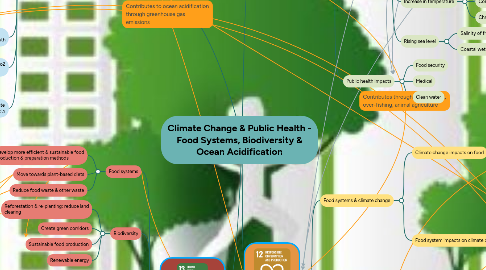
1. OCEAN ACIDIFICATION
1.1. Food chain alteration
1.1.1. Less top feeder fish catch - Livelihood loss
1.1.1.1. Decreased protein/PUFA
1.1.1.1.1. Malnutrition
1.1.1.1.2. Inequity/food insecurity (SDG10)
1.1.2. Ocean birds starve
1.1.2.1. Biodiversity loss
1.2. Exposure to ocean toxins/metals/harmful algal blooms
1.2.1. Trophic transfer - top feeders
1.2.1.1. Fisheries & aquaculture affected
1.2.1.2. Deep ocean anoxia
1.2.2. Aerosolisation - respiratory issues
1.3. Coral reef degradation
1.3.1. Tourism loss SDG9- Industry
1.3.1.1. Unemployment
1.3.1.2. Mental health stress
1.3.1.3. Nature disconnect & metabolic disorders
1.3.2. Medicine loss
1.3.3. Coastal erosion & diversity loss
1.4. Fish migration & habitat change, seagrass overgrowth
1.4.1. Ocean biodiversity loss (SDG14)
1.4.2. Invasive species
1.5. Decreased Co2 sink function
1.5.1. Increased atmp. Co2
1.5.1.1. Land biodiversity loss (SDG15)
1.6. Climate impacts
1.6.1. Local
1.6.1.1. Coastal upwelling
1.6.2. Distant
1.6.2.1. Biological carbon seq. pump
1.6.2.2. Polar sea acidification
2. CLIMATE CHANGE MITIGATION
2.1. Food systems
2.1.1. Develop more efficient & sustainable food production & preparation methods
2.1.2. Move towards plant-based diets
2.1.3. Reduce food waste & other waste
2.2. Biodiversity
2.2.1. Reforestation & re-planting; reduce land clearing
2.2.2. Create green corridors
2.2.3. Sustainable food production
2.2.4. Renewable energy
2.3. Ocean acidification
2.3.1. Reduce carbon dioxide emissions
2.3.1.1. Renewable energy
2.3.1.2. Sustainable food production
2.3.1.3. Re-planting, reducing land clearing
2.3.2. Growing sea plants
2.3.3. Reduce land-based sources of pollution
2.4. Direct health co-benefits
2.4.1. Reduced infectious diseases
2.4.2. Reduced chronic diseases
2.4.3. Better mental health
2.4.4. Improved nutrition, food & water security
2.4.5. Improved access to medicines
2.4.6. Supporting the determinants of health
3. FOOD SYSTEMS
3.1. Food systems & climate change
3.1.1. Climate change impacts on food
3.1.1.1. Reduced crop & native food yields
3.1.1.1.1. Increased malnutrition
3.1.1.2. Reduced food and water security
3.1.1.2.1. Increased food-borne diseases
3.1.1.2.2. Reduced availability
3.1.1.2.3. Lower food quality, increased toxicity
3.1.1.2.4. Reduced nutrients
3.1.2. Food system impacts on climate change
3.1.2.1. Water use
3.1.2.2. Greenhouse gas emissions
3.1.2.3. Pollution & waste (including food waste)
3.1.2.4. Animal agriculture, over-fishing
3.1.2.5. Species extinction & loss of biodiversity
3.1.2.6. Land use - deforestation, desertification
3.2. Food systems & public health
3.2.1. Unhealthy diets
3.2.1.1. Mental health
3.2.1.2. Non-communicable diseases
3.2.1.2.1. Cardiovascular disease
3.2.1.2.2. High blood pressure
3.2.1.2.3. Type 2 diabetes
3.2.1.2.4. Respiratory disease
3.2.1.2.5. Some cancers
3.2.1.3. Obesity
3.2.2. Increased infectious diseases, increased antimicrobial resistance
3.2.3. Food security
3.2.3.1. Social inequities
4. BIODIVERSITY
4.1. Climate change
4.1.1. Deforestation & habitat loss
4.1.1.1. Decline in plant biodiversity
4.1.1.1.1. Reduced oxygen production, carbon cycling
4.1.1.1.2. Decreased habitat
4.1.1.1.3. Decrease medicinal plants
4.1.1.2. Diminished animal biodiversity
4.1.1.2.1. Disrupt predator/prey relationships
4.1.1.2.2. Migration of invasive species
4.1.1.2.3. Decreased medicines
4.1.1.2.4. Species extinction & declining numbers
4.1.2. Overharvesting
4.1.2.1. Forests
4.1.2.2. Fish species
4.1.3. Pollution
4.1.3.1. Eutrophication
4.1.4. Increase in temperature
4.1.4.1. Increased extreme weather
4.1.4.2. Coral reefs
4.1.4.3. Change in migration/range
4.1.5. Rising sea level
4.1.5.1. Salinity of freshwater
4.1.5.2. Coastal wetland
4.2. Public health impacts
4.2.1. Food security
4.2.2. Medical
4.2.3. Clean water
